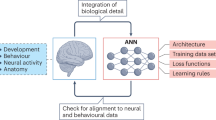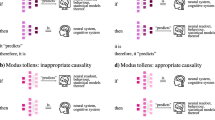Abstract
We present principles for an integrated neuroinformatics framework which makes explicit how models are grounded on empirical evidence, explain (or not) existing empirical results and make testable predictions. The new ontological framework makes explicit how models bring together structural, functional, and related empirical observations. We emphasize schematics of the model’s operation linked to summaries of empirical data (SEDs) used in both the design and testing of the model, with tests comparing SEDs to summaries of simulation results (SSRs) from the model. We stress the importance of protocols for models as well as experiments. We complement the structural ontology of nested brain structures with a functional ontology of Brain Operating Principles (BOPs) for observed neural function and an ontological framework for grounding models in empirical data. We present an implementation of this ontological framework in the Brain Operation Database (BODB), an environment in which modelers and experimentalists can work together by making use of their shared empirical data, models and expertise.










Similar content being viewed by others
References
Akil, H., Martone, M. E., & Van Essen, D. C. (2011). Challenges and opportunities in mining neuroscience data. Science, 331, 708–712.
Arbib, M. A., & Bischoff-Grethe, A. (2001). Summary databases and model repositories. In M. A. Arbib & J. S. Grethe (Eds.), Computing the brain: A guide to neuroinformatics (pp. 287–96). San Diego: Academic Press.
Ashburner, M., Mungall, C. J., & Lewis, S. E. (2003). Ontologies for biologists: a community model for the annotation of genomic data. Cold Spring Harbor symposia on quantitative biology, 68, 227–235.
Bandrowski, A., Gupta, A., Gupta, A., Larson, S., Martone, M. (2012). Exploring mammalian brain connectivity using NeuroLex. Neuroinformatics 2012 Abstracts: http://www.neuroinformatics2012.org/abstracts/exploring-mammalian-brain-connectivity-using-neurolex.
Bodenreider, O. (2004). The Unified Medical Language System (UMLS): integrating biomedical terminology. Nucleic acids research, 32, D267–D270.
Bonaiuto, J., Rosta, E., & Arbib, M. (2007). Extending the mirror neuron system model, I. Biological cybernetics, 96, 9–38.
Bota, M., & Arbib, M. A. (2004). Integrating databases and expert systems for the analysis of brain structures: connections, similarities, and homologies. Neuroinformatics, 2, 19–58.
Bota, M., & Swanson, L. W. (2007). The neuron classification problem. Brain Research Reviews, 56, 79–88.
Bota, M., Dong, H.-W., & Swanson, L. (2005). Brain architecture management system. Neuroinformatics, 3, 15–47.
Bowden, D. M., & Dubach, M. F. (2003). NeuroNames 2002. Neuroinformatics, 1, 43–60.
Brinkman, R. R., Courtot, M., Derom, D., Fostel, J. M., He, Y., et al. (2010). Modeling biomedical experimental processes with OBI. Journal of biomedical semantics, 1(Suppl 1), S7.
Bug, W. J., Ascoli, G. A., Grethe, J. S., Gupta, A., Fennema-Notestine, C., et al. (2008). The NIFSTD and BIRNLex vocabularies: building comprehensive ontologies for neuroscience. Neuroinformatics, 6, 175–194.
Campbell, K. E., Oliver, D. E., & Shortliffe, E. H. (1997). The unified medical language system toward a collaborative approach for solving terminologic problems. Journal of the American Medical Informatics Association, 5, 12–16.
Chau, W., & McIntosh, A. R. (2005). The Talairach coordinate of a point in the MNI space: how to interpret it. NeuroImage, 25, 408–416.
Dashti, A., Ghandeharizadeh, S., Stone, J., Swanson, L., & Thompson, R. F. (1997). Database challenges and solutions in neuroscientific applications. NeuroImage, 5, 97–115.
Dashti, A., Burns, G. A. P. C., Simmons, D., Swanson, L. W., Ghandeharizadeh, S., et al. (2001). The neuroanatomical rat brain viewer (NeuARt). In M. A. Arbib & J. S. Grethe (Eds.), Computing the brain: A guide to neuroinformatics (pp. 189–201). San Diego: Academic Press.
Demiris, Y., & Hayes, G. (2002). Imitation as a dual-route process featuring predictive and learning components: A biologically-plausible computational model. In K. Dautenhahn & C. Nehaniv (Eds.), Imitation in animals and artifacts. Cambridge: MIT Press.
Demiris, Y., & Khadhouri, B. (2006). Hierarchical attentive multiple models for execution and recognition of actions. Robotics and Autonomous Systems, 54, 361–369.
Demiris, Y., Aziz-Zadeh, L. A., Bonaiuto, J. J. (2013). Information processing in the mirror neuron system in primates and machines. Neuroinformatics.
Ellson, J., Gansner, E., Koutsofios, L., North, S., & Woodhull, G. (2002). Graphviz — open source graph drawing tools. Lecture Notes in Computer Science, 2265, 483–484.
Erlhagen, W., Mukovskiy, A., & Bicho, E. (2006). A dynamic model for action understanding and goal-directed imitation. Brain Research, 1083, 174–188.
Evans, A. C., Collins, D. L., Milner, B. (1992). An MRI-based stereotactic atlas from 250 young normal subjects. Journal Society for Neuroscience Abstract: 408.
Evans, A. C., Collins, D. L., Mills, S. R., Brown, E. D., Kelly, R. L., Peters, T. M. (1993) Nuclear Science Symposium and Medical Imaging Conference, 1993., 1993 I.E. Conference Record. 1813–17 vol. 3.
Fagg, A. H., & Arbib, M. A. (1998). Modeling parietal-premotor interactions in primate control of grasping. Neural Networks, 11, 1277–1303.
Gleeson, P., Crook, S., Cannon, R. C., Hines, M. L., Billings, G. O., et al. (2010). NeuroML: a language for describing data driven models of neurons and networks with a high degree of biological detail. PLoS Computational Biology, 6, e1000815.
Gleeson, P., Piasini, E., Crook, S., Cannon, R., Steuber, V., et al. (2012). The Open Source Brain Initiative: enabling collaborative modelling in computational neuroscience. BMC Neuroscience, 13, 1–2.
Gupta, A., Ludäscher, B., Grethe, J. S., & Martone, M. E. (2003). Towards a formalization of disease-specific ontologies for neuroinformatics. Neural Networks, 16, 1277–1292.
Gupta, A., Bug, W., Marenco, L., Qian, X., Condit, C., et al. (2008). Federated access to heterogeneous information resources in the Neuroscience Information Framework (NIF). Neuroinformatics, 6, 205–217.
Humphreys, B. L., Lindberg, D. A. B., Schoolman, H. M., & Barnett, G. O. (1998). The unified medical language system: an informatics research collaboration. Journal of the American Medical Informatics Association, 5, 1–11.
Imam, F. T., Larson, S. D., Bandrowski, A., Grethe, J. S., Gupta, A., & Martone, M. E. (2012). Development and use of ontologies inside the neuroscience information framework: a practical approach. Frontiers in Genetics, 3, 111.
Kotter, R. (2004). Online retrieval, processing, and visualization of primate connectivity data from the CoCoMac database. Neuroinformatics, 2, 127–144.
Laird, A. R., Lancaster, J. L., & Fox, P. T. (2005). BrainMap: the social evolution of a human brain mapping database. Neuroinformatics, 3, 65–78.
Lancaster, J., Summerlin, J., Rainey, L., Freitas, C., & Fox, P. (1997). The talairach daemon: a database server for talairach atlas labels. NeuroImage, 5, S633.
Malone, J., Holloway, E., Adamusiak, T., Kapushesky, M., Zheng, J., et al. (2010). Modeling sample variables with an experimental factor ontology. Bioinformatics (Oxford, England), 26, 1112–1118.
Migliore, M., Morse, T. M., Davison, A. P., Marenco, L., Shepherd, G. M., & Hines, M. L. (2003). ModelDB. Neuroinformatics, 1, 135–139.
Nielsen, F., & Hansen, L. (2000). VDE2000 - visualization development environments (pp. 76–81). New Jersey, USA: Princeton.
Nordlie, E., Gewaltig, M. O., & Plesser, H. E. (2009). Towards reproducible descriptions of neuronal network models. PLoS Computational Biology, 5, e1000456.
Oztop, E., & Arbib, M. A. (2002). Schema design and implementation of the grasp-related mirror neuron system. Biological Cybernetics, 87, 116–140.
Paxinos, G., & Watson, C. (2009). Brain navigator. Boston, MA, USA: Elsevier.
Plangprasopchok, A., Tinroongroj, N., Bonaiuto, J., Arbib, M. A. (2006). User’s manual for the Brain Operation Database: BODB (Version 3). http://neuroinformatics.usc.edu/wp-content/uploads/2012/03/BODB_Manual_09-20-10.pdf.
Poldrack, R., Kittur, A., Kalar, D., Miller, E., Seppa, C., et al. (2011). The cognitive atlas: toward a knowledge foundation for cognitive neuroscience. Frontiers in neuroinformatics, 5, 17.
Russ, T. A., Ramakrishnan, C., Hovy, E. H., Bota, M., & Burns, G. A. P. C. (2011). Knowledge engineering tools for reasoning with scientific observations and interpretations: a neural connectivity use case. BMC bioinformatics, 12, 351.
Shahabi, C., Dashti, A., Burns, G. A. P. C., Ghandeharizadeh, S., Swanson, L. (1999). Visualization of Spatial Neuroanatomical Data. Proceedings of the 3rd international conference on visual information systems.
Smith, B., Ashburner, M., Rosse, C., Bard, J., Bug, W., et al. (2007). The OBO Foundry: coordinated evolution of ontologies to support biomedical data integration. Nature Biotechnology, 25, 1251–1255.
Soldatova, L. N., & King, R. D. (2006). An ontology of scientific experiments. Journal of the Royal Society, Interface/the Royal Society, 3, 795–803.
Swanson, L. (2003). Brain maps, structure of the rat brain (3rd ed.). San Diego, CA: Academic.
Talairach, J., & Tournoux, P. (1988). Co-planar stereotaxic atlas of the human brain. New York: Thieme.
Teeters, J. L., Harris, K. D., Millman, K. J., Olshausen, B. A., & Sommer, F. T. (2008). Data sharing for computational neuroscience. Neuroinformatics, 6, 47–55.
Völkel, M., Krötzsch, M., Vrandecic, D., Haller, H., Studer, R. (2006). Semantic Wikipedia. Proceedings of the 15th international conference on World Wide Web WWW 06 5: 585–94.
Acknowledgments
This work was supported in part by the National Science Foundation under Grant No. 0924674 as part of the University of Southern California Brain Project (USCBP). BODB was designed and implemented by many people under the leadership of Michael A. Arbib. Salvador Marmol designed ARDB (the Action Recognition Database), the precursor of BODB, and Rishabh Tandon updated it and released ARDB version 2.0. Anon Plangprasopchok took the lead in implementing the previous version of BODB for which Nantana Tinroongroj developed our first Talairach Applet. Implementation of the current version of BODB and development of BrainSurfer was primarily the work of James Bonaiuto. We thank Peter Fox and Jack Lancaster for making available the data from their Talairach Demon for our Talairach Applet (and now its extension in BrainSurfer), and David Marques of Elsevier and George Paxinos and Charles Watson for making portions of the electronic form for the Paxinos-Watson brain atlas of the macaque available for use in BrainSurfer.
Author information
Authors and Affiliations
Corresponding author
Appendix: Listing of Brain Operating Principles
Appendix: Listing of Brain Operating Principles
Rights and permissions
About this article
Cite this article
Arbib, M.A., Plangprasopchok, A., Bonaiuto, J. et al. A Neuroinformatics of Brain Modeling and its Implementation in the Brain Operation Database BODB. Neuroinform 12, 5–26 (2014). https://doi.org/10.1007/s12021-013-9209-y
Published:
Issue Date:
DOI: https://doi.org/10.1007/s12021-013-9209-y




